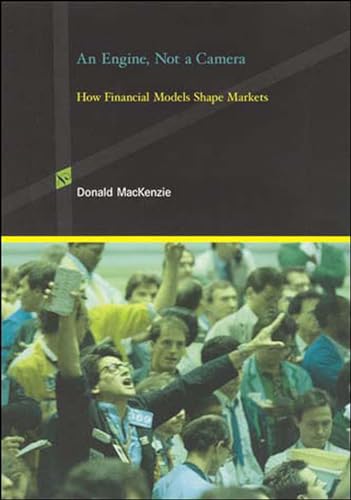An Engine, Not a Camera: How Financial Models Shape Markets (Inside Technology Series) - Softcover
Book 11 of 63: Inside Technology
Synopsis
In An Engine, Not a Camera, Donald MacKenzie argues that the emergence of modern economic theories of finance affected financial markets in fundamental ways. These new, Nobel Prize-winning theories, based on elegant mathematical models of markets, were not simply external analyses but intrinsic parts of economic processes.
Paraphrasing Milton Friedman, MacKenzie says that economic models are an engine of inquiry rather than a camera to reproduce empirical facts. More than that, the emergence of an authoritative theory of financial markets altered those markets fundamentally. For example, in 1970, there was almost no trading in financial derivatives such as "futures." By June of 2004, derivatives contracts totaling $273 trillion were outstanding worldwide. MacKenzie suggests that this growth could never have happened without the development of theories that gave derivatives legitimacy and explained their complexities.
MacKenzie examines the role played by finance theory in the two most serious crises to hit the world's financial markets in recent years: the stock market crash of 1987 and the market turmoil that engulfed the hedge fund Long-Term Capital Management in 1998. He also looks at finance theory that is somewhat beyond the mainstream―chaos theorist Benoit Mandelbrot's model of "wild" randomness. MacKenzie's pioneering work in the social studies of finance will interest anyone who wants to understand how America's financial markets have grown into their current form.
"synopsis" may belong to another edition of this title.
About the Author
Donald MacKenzie is Professor of Sociology (Personal Chair) at the University of Edinburgh. His books include Inventing Accuracy (1990), Knowing Machines (1996), and Mechanizing Proof (2001), all published by the MIT Press. Portions of An Engine, not a Camera won the Viviana A. Zelizer Prize in economic sociology from the American Sociological Association.
"About this title" may belong to another edition of this title.
Other Popular Editions of the Same Title
Search results for An Engine, Not a Camera: How Financial Models Shape...
An Engine, Not a Camera
Seller: Books Puddle, New York, NY, U.S.A.
Condition: New. pp. 392. Seller Inventory # 26696062
Engine, Not a Camera : How Financial Models Shape Markets
Seller: GreatBookPrices, Columbia, MD, U.S.A.
Condition: As New. Unread book in perfect condition. Seller Inventory # 5636414
An Engine, Not a Camera: How Financial Models Shape Markets (Inside Technology) Format: Paperback
Seller: INDOO, Avenel, NJ, U.S.A.
Condition: As New. Unread copy in mint condition. Seller Inventory # RH9780262633673
Engine, Not a Camera : How Financial Models Shape Markets
Seller: GreatBookPrices, Columbia, MD, U.S.A.
Condition: New. Seller Inventory # 5636414-n
An Engine, Not a Camera: How Financial Models Shape Markets (Inside Technology) Format: Paperback
Seller: INDOO, Avenel, NJ, U.S.A.
Condition: New. Brand New. Seller Inventory # 9780262633673
An Engine, Not a Camera (Paperback)
Seller: Grand Eagle Retail, Bensenville, IL, U.S.A.
Paperback. Condition: new. Paperback. In An Engine, Not a Camera, Donald MacKenzie argues that the emergence of modern economic theories of finance affected financial markets in fundamental ways. These new, Nobel Prize-winning theories, based on elegant mathematical models of markets, were not simply external analyses but intrinsic parts of economic processes.Paraphrasing Milton Friedman, MacKenzie says that economic models are an engine of inquiry rather than a camera to reproduce empirical facts. More than that, the emergence of an authoritative theory of financial markets altered those markets fundamentally. For example, in 1970, there was almost no trading in financial derivatives such as "futures." By June of 2004, derivatives contracts totaling $273 trillion were outstanding worldwide. MacKenzie suggests that this growth could never have happened without the development of theories that gave derivatives legitimacy and explained their complexities.MacKenzie examines the role played by finance theory in the two most serious crises to hit the world's financial markets in recent years- the stock market crash of 1987 and the market turmoil that engulfed the hedge fund Long-Term Capital Management in 1998. He also looks at finance theory that is somewhat beyond the mainstream-chaos theorist Benoit Mandelbrot's model of "wild" randomness. MacKenzie's pioneering work in the social studies of finance will interest anyone who wants to understand how America's financial markets have grown into their current form. A pioneering work in the social studies of finance describes how the emergence of modern finance theory has affected financial markets in fundamental ways--as an engine that shapes them rather than a camera that reproduces their every detail. Shipping may be from multiple locations in the US or from the UK, depending on stock availability. Seller Inventory # 9780262633673
An Engine, Not a Camera
Seller: Rarewaves USA, OSWEGO, IL, U.S.A.
Paperback. Condition: New. Seller Inventory # LU-9780262633673
An Engine, Not a Camera
Seller: Biblios, Frankfurt am main, HESSE, Germany
Condition: New. pp. 392. Seller Inventory # 18696052
Engine, Not a Camera : How Financial Models Shape Markets
Seller: GreatBookPricesUK, Woodford Green, United Kingdom
Condition: New. Seller Inventory # 5636414-n
Buy New
Ships from United Kingdom to U.S.A.
Quantity: Over 20 available
An Engine, Not a Camera: How Financial Models Shape Markets (Inside Technology)
Seller: Toscana Books, AUSTIN, TX, U.S.A.
Paperback. Condition: new. Excellent Condition.Excels in customer satisfaction, prompt replies, and quality checks. Seller Inventory # Scanned0262633671

